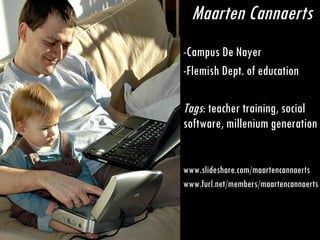Maarten Cannaerts
- 1. Maarten Cannaerts Campus De Nayer Flemish Dept. of education Tags : teacher training, social software, millenium generation www.slideshare.com/maartencannaerts www.furl.net/members/maartencannaerts
- 2. 1 . Added value of e -learning?
- 3. 1 . More learning 2. Better learning
- 4. We want More learning
- 5. We want More learning Learning is key to all problems (A waiter with better education sells more beer !)
- 6. Life long learning ĻC reach older learners ĻC higher participation rates ĻC combine work/study ĻC reach minority groups ĻC onthejob learning ĻC upskilling of competencies ĻC reach millenium generationĄ 1 . More learning
- 7. The classroom paradigm isnĄŊt scalable
- 8. 2. Better learning
- 9. 2. Better learning Learning in 2000 is different from learning in 1900.
- 10. 2. Better learning Learning in 2000 is different from learning in 1900. Information literacies, global education, constructing knowledge, networkingĄ
- 11. Talking about ĄŪgoodĄŊ e-learning = talking about good ĄŪlearningĄŊ
- 12. 2 . Biggest challenge in e -learning?
- 13. Move fromĄ
- 14. ?
- 15. Ą° sit down and shut upĄą Ą° we will save moneyĄą Ą° we wonĄŊt need teachersĄą Move fromĄ
- 16. Move fromĄ Ą ģŲīĮĄ
- 17. ?
- 18. Move fromĄ Ą ģŲīĮĄ Ą° can I join please?Ąą Feedback, group dynamics, personal trajects, adaptive environments, link with own experiences and interestsĄ
- 19. 3 . Myths of e -learning?
- 20. Myth #1: Ą° we will save moneyĄą
- 21. Myth #2: Ą° e-learning = isolated learningĄą
- 22. 4 . How to start using e -learning?
- 23. Method 1: top down
- 25. Method 3: the right way
- 26. There is no single right way There is no uniform right way
- 27. Careful blend. Start from experiments, feed them, give them room + make sure the findings are translated. COMMUNICATE ! Listen to problems, but donĄŊt fear discussion. EXPERIMENT ! Raise expectations. SUPPORT ! Project management. Budget! LEARN ! Vision = long term! Consistency! Make room for differences in speed. Who does what? Support from management, manage change, BENEFITS Ą Ą Ą Ą
- 28. COMPLETE the puzzle!
- 29. Enjoy the course! [email_address]




























![Enjoy the course! [email_address]](https://image.slidesharecdn.com/cannaerts-1207920621247500-8/85/Maarten-Cannaerts-29-320.jpg)